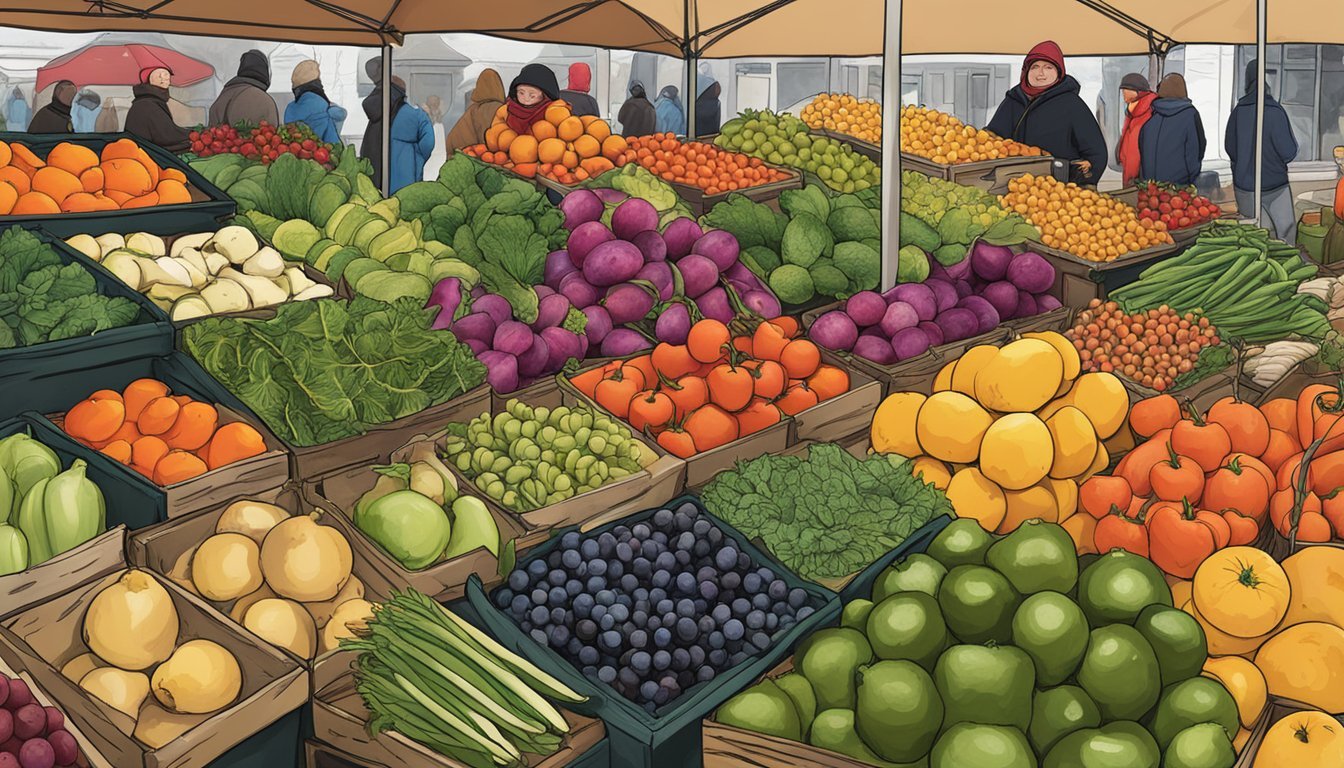Connecticut Seasonal Fruit & Vegetables in January
Your Guide to Fresh Produce
This Article is Part of our Connecticut Seasonal Fruit & Veg Calendar
In the heart of winter, Connecticut's seasonal produce offerings reflect the robust nature of root vegetables and the storage capabilities of certain fruits. January is a month where farmers' markets and local grocery stores carry a more limited but still varied selection of items that can withstand the cold Northeastern climate. Among these are hearty vegetables such as potatoes, carrots (how long do carrots last?), and winter squash, which are celebrated for their earthy flavors and versatility in the kitchen.
Storage crops play a crucial role during this time, with apples (how long do apples last?) being a prime example of a fruit that, when stored properly, remains available to consumers even in the depths of winter. These storage apples come from the late harvests and offer a crisp, sweet taste that is a welcome reminder of the fall bounty. Meanwhile, cold frames and greenhouses provide some fresh greens like kale, (What wine goes well with kale?) which thrives in cooler temperatures and can be harvested throughout much of the winter.
Connecticut residents embrace these seasonal offerings by incorporating them into warming dishes that suit the chilly weather. Soups, stews, and roasted vegetable preparations are common fare, often featuring the deep, sweet flavors that develop in these produce items after a frost. While the range of fresh produce may be narrower than in the summer and fall months, January still presents opportunities for nutritious and flavorful eating, sourced from the resilient yields of local agriculture.
Overview of Connecticut's Seasonal Climate and Its Impact on Produce
Connecticut's diverse climate significantly influences the seasonality and variety of its agricultural produce. The state's agriculture thrives on the seasonal variations that range from cold winters to warm summers.
Winter Weather Patterns in Connecticut
Connecticut's winters bring cold temperatures and can include substantial snowfall, which generally spans from November to March. The cooler climate regime during this period necessitates the use of protective measures in agriculture, such as greenhouses, to extend growing seasons for certain crops. The state often sees changes in winter weather patterns that can affect the viability of winter produce.
Seasonal Produce Variations
The availability of fresh produce in Connecticut varies by season. Winter's chill brings about a more limited selection of fresh, local produce:
Root vegetables: carrots, potatoes, and beets.
Leafy greens: such as kale and spinach can be grown in cold frames or greenhouses.
Storage crops: including apples and squashes, typically harvested in fall, remain available.
During winter, Connecticut's local agriculture relies heavily on these crops that can withstand colder temperatures or be stored effectively through the colder months.
Understanding the Connecticut Growing Season
The typical growing season in Connecticut runs from April to November, heavily influenced by the transition from spring's thaw to fall's first frost. Here's what to expect for each season:
Spring: A gradual increase in temperatures allows for the beginning of the planting season. Frost-sensitive plants, however, must wait until the risk decreases.
Summer: Peak growing season, characterized by longer days and warmer weather, allows for a diverse array of produce including berries, tomatoes, and peppers.
Fall: Harvest time for many crops, but as temperatures drop, growth slows and preparations for winter storage or protective planting begins.
Connecticut's farmers adapt to these seasonal changes to maximize the quality and availability of their produce year-round.
Seasonal Fruits Available in January
In January, Connecticut's seasonal fruit offerings are limited due to the cold climate. However, certain fruits are still available, including storage crops and imported varieties which provide residents with a range of healthy options.
Citrus Fruits and Apples
Citrus Fruits: Despite Connecticut's chilly January, citrus fruits like oranges and lemons are in peak season elsewhere, and they make their way to market shelves in this region. They are packed with vitamin C, which is ideal for boosting immunity during the winter months.
Apples: While apple harvests come to an end in the fall, many varieties are kept in cold storage to allow them to be enjoyed throughout the winter. Apples such as Fuji, Gala, and Granny Smith are often available during this time.
Imported Fruit Varieties
Connecticut grocers import a variety of fruits to ensure diversity in produce options. Tropical fruits that are not affected by Connecticut's winter, such as bananas, pineapples, and mangoes, are commonly found in stores during this time. These fruits are sourced from warmer regions where they are currently in season.
Utilizing Cold Storage for Local Fruits
Local farms utilize cold storage technologies to extend the availability of certain fruits beyond their traditional growing season. Here's a brief list of fruits commonly stored and enjoyed throughout the winter months:
Apples: Storing select apple varieties in controlled environments preserves their freshness.
Pears: Just like apples, pears can be kept in cold storage for extended enjoyment.
These fruits maintain much of their taste and nutritional value, thanks to modern storage methods, making them a mainstay in Connecticut's January fruit scene.
Seasonal Vegetables Available in January
During January, Connecticut's cold climate limits the range of fresh produce. However, certain vegetables thrive and are available due to their ability to withstand the frosty weather.
Root Vegetables and Tubers
This category includes some of the most resilient vegetables. Root vegetables and tubers store energy underground, allowing them to survive the harsh New England winters. In January, Connecticut offers:
Potatoes: A staple tuber with versatile use in kitchen.
Carrots: Known for their sweetness, enhancing when harvested in cooler temperatures.
Turnips: Hardy with a slightly peppery flavor, suitable for stews and roasts.
Onions: Essential for flavoring a multitude of dishes, onions are available all winter.
Cold Weather Greens
Greens that can tolerate the cold provide nutrition and flavor even in the midst of winter. Key players in January include:
Kale: It withstands frost, which can sweeten its normally bitter leaves.
Collards: Similar to kale, collards are also frost-resistant and often sweeter in the winter.
Winter Squash and Pumpkins
Although most associated with autumn, some winter squash and pumpkins can be stored and enjoyed throughout the cold months:
Winter Squash: Varieties like butternut or acorn squash are harvested in the fall but keep well into winter.
Pumpkins: While they are a hallmark of fall, pumpkins stored properly remain good for consumption in January.
Health Benefits of Eating Seasonally
Eating seasonally offers a host of benefits, ranging from enhanced nutrition to supporting local communities and the environment.
Nutritional Advantages of Seasonal Produce
Seasonal fruits and vegetables are often at their peak in flavor and nutrients. They are harvested when naturally ripe, allowing them to develop fully and soak up more sunlight, which can lead to higher levels of antioxidants and vitamins. For example, cruciferous vegetables like kale and brussels sprouts, which are in season in Connecticut during fall and winter, are packed with vitamins A, C, and K. In contrast, root vegetables such as carrots and turnips, also winter crops, are rich in dietary fiber and vitamin C.
Citrus fruits, which are winter-seasonal, provide a high dose of vitamin C, vital for immune system support during colder months.
Supporting Local Economy and Sustainability
Purchasing seasonal produce supports local farmers and the economy, ensuring that money stays within the community. It also often requires less transportation and storage, which translates to a smaller carbon footprint.
Local farmers' markets in Connecticut, for instance, offer a variety of winter produce like squash and parsnips.
By buying these items locally and in-season, consumers help reduce the environmental impacts associated with shipping food long distances.
Additionally, seasonal consumption can encourage more sustainable farming practices that align with natural ecological cycles and help preserve local biodiversity.
Where to Find Seasonal Produce in Connecticut
In January, residents of Connecticut have various options for sourcing fresh, seasonal produce despite it being the heart of winter. These include community-supported ventures and local businesses that focus on bringing fresh food to the table.
Farmers' Markets and Food Co-ops
Although some might assume that farmers' markets are a feature of the warmer months, a number of them operate year-round in Connecticut. Buyers can visit indoor markets like the CitySeed's Wooster Square Farmers' Market in New Haven, which adjusts to an indoor setting for the colder months, providing a selection of seasonal produce. Food co-ops, such as the Willimantic Food Co-op, also remain open throughout the year and are an excellent source for fresh, locally-grown fruits and vegetables.
Local Grocery Stores
Local grocery stores often feature sections dedicated to locally sourced and in-season produce. Shoppers looking for seasonal produce will likely find it marked as Connecticut Grown to emphasize local agriculture. Stores also collaborate with local farms during this period to stock a varied selection of seasonal items.
Community-Supported Agriculture (CSA)
Community-Supported Agriculture programs are highly active in Connecticut and provide a direct pipeline from farm to consumer. Participants in CSAs receive periodic deliveries or pick-up allocations of fresh produce throughout the year. It’s important to note programs such as Hickories, Riverbank Farm, or Holbrook Farm have sign-up periods and predetermined pickup times that need to be adhered to by members.
Cooking and Storing Seasonal Produce
In January, Connecticut offers a limited variety of seasonal produce, but with the right recipes and storage methods, one can maximize flavor and longevity. Utilizing preservation techniques ensures that the available winter produce can be enjoyed for an extended period.
Recipe Ideas for January Produce
Root vegetables and hearty winter greens dominate the seasonal availability in Connecticut during January. Home cooks can experiment with dishes like:
Roasted root vegetables: A medley of carrots, potatoes, and beets tossed in olive oil, salt, and herbs, then roasted to perfection.
Kale salads: Massaged kale paired with dried fruits and nuts for a nutritious meal.
Preservation Techniques
Preserving January produce allows for extended use, especially when fresh options are sparse:
Canning: Making pickles from local cucumbers or canning sauces with winter tomatoes.
Freezing: Blanching and freezing greens like kale and spinach for later use.
Best Practices for Storage
Proper storage extends the life of produce:
Root Vegetables: Store carrots, beets, and potatoes in a cool, dark place, preferably in breathable containers like burlap sacks.
Greens: Keep kale and other greens in the crisper drawer of the refrigerator, wrapped loosely in a damp towel to maintain moisture.
Gardening Tips for Connecticut Residents
In Connecticut, January is a time for gardeners to strategize and nurture plants in controlled environments due to the cold climate.
Planning the Gardening Season
Connecticut gardeners should initiate their season planning by reviewing the hardiness zone specific to their area, which influences when to sow different types of crops. They must consider cool-weather crops that can withstand the state's chilly early spring. It's essential to develop a planting calendar, accounting for both the last frost dates and the length of growing seasons. Gardeners can optimize their efforts by selecting varieties known to perform well in Connecticut's conditions.
Hardiness Zones in Connecticut: Zones 5-7
Cool-Weather Crop Examples: Lettuce, spinach, peas, and root vegetables
Planning Tools: Planting calendars, garden journals
Indoor and Greenhouse Gardening
For gardeners eager to get a start despite the snow, indoor and greenhouse gardening provide viable options. They can sow seeds of cool-weather crops indoors and later transplant them outdoors when the climate permits. A greenhouse allows for a broader range of crops to be started earlier, extending the growing season. Gardeners should maintain consistent temperatures within the greenhouse and carefully monitor humidity levels to prevent plant diseases.
Indoor Sowing: Start seeds in trays or pots using a high-quality potting mix.
Greenhouse Management:
Temperature: Keep between 45-70°F (7-21°C)
Humidity: Adequate ventilation to control moisture
Supporting Connecticut's Agricultural Sector
In Connecticut, supporting the agricultural sector extends beyond the purchase of seasonal fruits and vegetables; it involves community engagement and education. These efforts help to sustain local economies and preserve the state's farming heritage.
Advocacy and Consumer Choices
Consumers have the power to influence the success of Connecticut's agriculture. By choosing to buy locally-sourced produce, they contribute to the viability of family farms and the local economy. The state hosts a variety of farmers' markets and community-supported agriculture (CSA) programs, where consumers can purchase seasonal fruits and vegetables directly from the growers. Furthermore, initiatives such as the Connecticut Grown program aim to promote and identify Connecticut-produced agricultural products.
Farmers' Markets: A direct avenue to support local farmers and purchase fresh produce.
CSA Programs: A subscription-based model that allows consumers to receive a share of the harvest throughout the season.
Connecticut Grown: A state-sponsored label that makes it easier for consumers to identify and choose local products.
By opting for Connecticut-sourced goods, consumers help to ensure farmland preservation and the longevity of the state's agricultural heritage.
Educational Resources and Programs
Connecticut's Department of Agriculture provides educational resources and programs aimed at bolstering the agriculture sector. They focus on the importance of good agricultural practices and encourage the next generation of farmers through initiatives like the Farm Viability Grants for educational and research-based projects.
Produce Safety Education: The state offers training to help farmers comply with the Food Safety Modernization Act, ensuring high standards for local produce.
Youth Engagement: Programs targeting youth to foster an interest in agriculture, including involvement in FFA (formerly Future Farmers of America) and 4-H clubs.
These educational efforts not only secure a safer food supply but also work to instill a lifelong appreciation and understanding of agriculture in Connecticut's residents.
Conclusion
In January, Connecticut residents have access to a variety of storage crops and some greenhouse-grown produce. Availability is more limited compared to the abundant growing months, but there remains a selection for those seeking fresh, local foods.
Vegetables:
Carrots
Potatoes
Onions
Winter squash
Garlic
Fruits:
Apples (from cold storage)
Connecticut's local farms and markets will likely offer these fruits and vegetables. Despite the colder season, they maintain quality and taste due to advanced storage techniques. It is recommended for consumers to visit local farmers' markets or to subscribe to community-supported agriculture (CSA) programs to get the freshest seasonal produce.
Greenhouse-grown produce can also include items like:
Lettuce
Herbs
Greens
Farmers employ controlled environments to ensure these crops can be available, supporting year-round sustainability. Families and chefs alike can continue to enjoy fresh, locally-sourced ingredients even amidst the chilly winter temperatures. For detailed availability, it is advised to check with local farm stands, stores, and CSA updates. This encourages support for Connecticut's agricultural community and promotes a farm-to-table ethic, regardless of the season.








